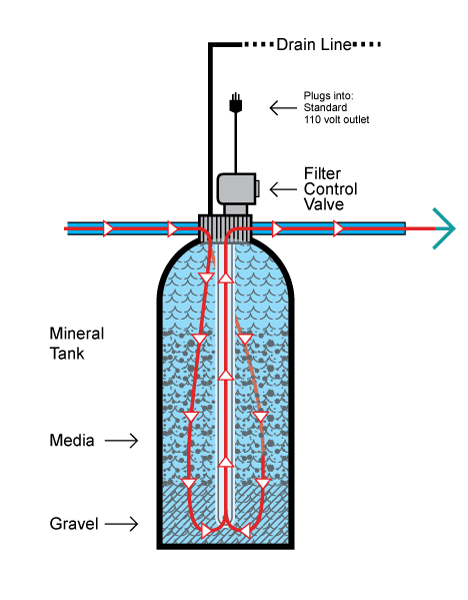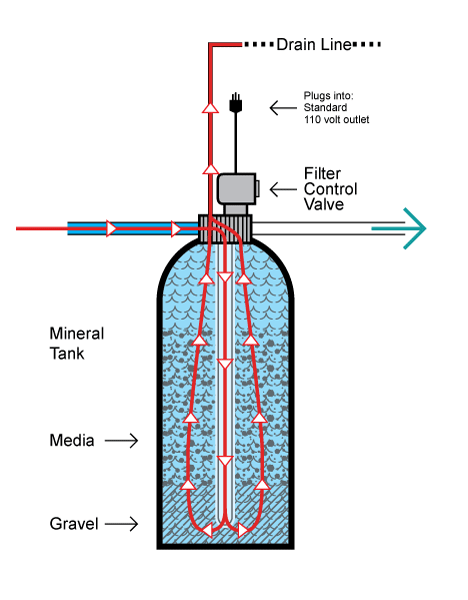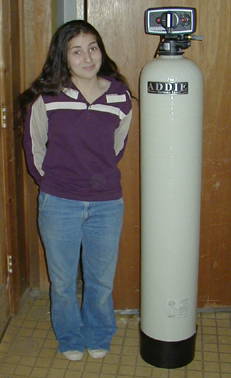How Backwashing Water Filters Work
To Read This Special Backwashing Filter Issue on Our Website
The Pure Water Occasional's Guide to Backwashing Water Filters
|
To put things in perspective, a 10" X 54" residential backwashing filter, a common size, is slightly taller and thinner than a short woman. 10" is the diameter of the tank, and 54" is its height. The control valve on top adds another 6" or so.
|
Backwashing Filters
Backwashing water filters are large tank-style filters that get their name from the fact that they clean and renew themselves by backwashing. Backwashing consists of reversing the flow of water so that it enters from the bottom of the filter bed, lifts and rinses the bed, then exits to drain through the top of the filter tank.
The filter bed itself is a granular substance that is usually referred to as the filter medium. Media (media is plural, medium is singular) are numerous and varied. Common media are granular carbon, sand, garnet, anthracite, zeolite, granular manganese dioxide, and greensand. Many media are known by their brand names of the leading product in the category: Centaur, Filox, Birm, and KDF, for example. The medium is chosen according to the purpose of the filter. If the user wants to remove iron, Birm might be used; if chlorine reduction is the objective, carbon might be the choice. The same filter tank and control system, with some slight modifications in tuning, would be used for both the iron and dechlorination filters.
 |
|---|
Backwashing Filter in "Service" Position. The arrows indicate the path the water follows when it is being filtered and sent to the home. |
Service Flow
The picture above shows the filter in "service" position. This is how it works when it is doing the job it is designed to do--treating the water and sending it to the home. The unfiltered water enters from the left and is routed by the control valve into the filter tank. The water then filters slowly through the medium until it reaches the bottom of the tank where it is collected through a specially-designed sieved "basket" at the bottom of the center tube seen in the picture. The filtered water then passes up through the center tube, called a "riser" or a "dip tube," goes through the control valve and exits the right side of the filter.
Note that there's a drain line in the picture, but no water goes through it during the filter's "service" function.
The Backwash
As the filter operates in the service mode, it traps and holds particles in the filter bed. Also, since water's nature is to follow the path of least resistance, after a time it begins to cut channels through the medium. As channels or holes in the media bed form, water begins to flow around rather than through the medium. This process is called "channeling," and it reduces the effectiveness of the filter considerably.
At a preset time, the control valve initiates a "backwash" to clean the medium of collected particles and to resettle the bed and eliminate channels that have formed.
The backwash is accomplished by sending water down the riser tube from which it enters the filter tank at the bottom. The force of the water is such that it actually lifts the bed, swirling and tossing the granular medium. The water leaves the filter tank through the control valve, which routes it through the filter's drain line. Particles that were being held in the bed are washed to drain.
The backwash is an intense rinsing and tossing of the medium that lasts for several minutes. In a standard residential filter, a typical backwash lasts about ten minutes.
After the backwash, the control valve initiates a "rinse" of the bed during which water flows downward through the medium, up through the riser tube, and out the drain. The purpose of this rinse is to rinse and settle the bed and prepare it for return to service flow.
 |
|---|
| Backwashing Filter in Backwash Mode. The arrows indicate the path taken by water when the bed is being lifted and cleansed. Note that the backwash water is flowing out the drain line. The control valve allows the passage of untreated water to the home during backwash. |
Backwashing Filters Incidentals
Tanks. Called "mineral tanks," most are made of polypropylene and/or polyethylene with fiberglass reinforcement. Mineral tanks are very strong and usually guaranteed for up to ten years by the manufacturer. The tanks are called "mineral" tanks because water treatment professionals refer to the ingredients, the filter media, collectively as "mineral."
Control Valves. Most modern filters use timer-style controls in which an electric timer initiates and controls the backwash of the filter at a pre selected time. Meters, which backwash the media when a certain number of gallons have been treated, are used widely on water softeners but much less frequently on filters. Some very sophisticated setups can initiate backwash in response to a pressure differential between the incoming and outgoing water, but for most situations, the standard, reliable timer control is preferred on backwashing filters. Most control valves are made by three large companies: Fleck, GE (Autotrol), and Clack.
Media. With a few minor modifications, a backwashing filter can serve many purposes according to the filter medium used. Here are some of the more common granular media used in backwashing filters:
Granular Activated Carbon. For chlorine and chloramine reduction, taste/odor improvement, and general chemical reduction. Carbon can also remove sediment and even iron if the iron is pretreated properly. Granular carbon is the preferred treatment for many chemical contaminants. It is perhaps the most versatile and universal of filter media.
Birm: For reduction of iron and manganese, under the right conditions. As iron media go, Birm is relatively light in weight and hence easy to backwash. It is also low in cost, so it's a popular iron medium although it has some drawbacks.
Calcite: To increase the pH of acidic water . Calcite is a sacrificial medium that dissolves as it works and has to be replaced.
Centaur Catalytic Carbon: Reduction of chlorine, chloramine, hydrogen sulfide, and iron. A relatively expensive grade of specially prepared carbon, Centaur is a favorite for chloramine removal on city water systems.
Multi-Media, consisting of layers of such natural elements as garnet, sand, and anthracite, Multi-Media beds are used for the reduction of sediment and oxidized iron. Multi-media filters are slowly being replaced by newer granular zeolite media.
Filter Ag, ChemSorb, Micro Z. These are all common "sediment" media. They reduce particles in water down to 20 to 5 microns. These are usually natural zeolite products.
Greensand. Reduction of iron and hydrogen sulfide. Greensand is usually used with a potassium permanganate feeder.
Filox. A natural mined mineral, Filox is known for high level iron removal and reduction of hydrogen sulfide odors. It is very dense.
Backwash Rate. Backwash flow rates differ significantly from filter to filter.The correct backflow rate is essential to proper operation of a backwashing filter.The correct backwash flow rate is determined by considering the square footage of the surface of the media bed and the density of the media. The filter must have a flow control installed in its drain line to allow a backwash flow rate sufficient to raise and cleanse the media bed but restrictive enough to prevent media from being washed out the drain line. For example, a carbon bed in a 10" X 54" filter tank is usually installed with a five gallon-per-minute flow restrictor. Five GPM is sufficient to lift and clean the bed, but carbon is dense enough that it will not be washed out through the drain line during backwash. By contrast, KDF, a very dense medium, requires a backwash of more than 15 GPM in the same filter. Note that the correct backwash rate is a requirement. If the KDF filter is installed in a water line with only a 10 gallon-per-minute flow capacity, it will soon become overloaded with sediment and fail.
Service Flow. Service flow of the filter is limited by the size of the tank and the nature of the medium. Some media require longer to work than others. Media are rated according to the service flow they can support by a measurement called "empty bed contact time." When the recommended contact time for the medium is violated by excess service flow, the filter is less effective and the life of the medium is usually shortened. It should be noted that empty bed contact time requirements are frequently violated in residential filters. For example, filter carbon in a 10" X 54" filter has a performance limit of about 3 gallons per minute, but such filters are frequently used in residential applications with much higher flow rates. There is no great harm in this since the undersized filter removes most of the chlorine most of the time. However, if the same filter is used to reduce dangerous organic chemicals from well water, its upper service flow rate should be limited to perhaps one GPM, and exceeding this limit could have serious consequences.
Media Content of Common Tank Sizes
For backwashing to be effective, the tank mineral tank must not be overloaded. This table shows the standard "media load" for most common small residential backwashing filters. It is important to note that there are two crucial media dimensions to consider in setting up a backwashing filter. The media load must be suitable for the tank size, but it is the square foot dimension of the top of the media bed that determines the backwash flow requirement. Thus, a 10" X 54" tank, which holds 1.5 cubic feet of media, has the same backwash requirement as a 10" X 44" tank that holds 1.25 cubic feet. That's because the surface area of the top of the bed is the same for both tanks.
In the table below, a typical backwash flow requirement is given in round numbers for filter carbon, probably the most standard medium used in residential backwashing filters, and Filox-R a very dense iron reduction medium. (Carbon weighs 25 lbs. per cubic foot; Filox weighs 114.) The number given for Filox is for warm water. To size correctly, water temperature must be considered. (Cold water backwashes a filter much more efficiently than warm water, so backwash rates can be decreased in colder water.)
| Tank Size | Standard Media Load in Cubic Feet | Media Bed Surface Area in Square Feet | Backwash Flow Requirement in Gallons-Per-Minute for Filter Carbon/ Filox (warm water). |
|---|---|---|---|
| 8" X 44" | 0.75 | 0.35 | Carbon: 4 Filox:7 |
| 9" X 48" | 1.00 | 0.45 | Carbon: 4 Filox:8 |
| 10" X 44" | 1.25 | 0.55 | Carbon: 5 Filox:12 |
| 10" X 54" | 1.5 | 0.55 | Carbon: 5 Filox:12 |
| 12" X 48" or 12" X 52" | 2.0 | 0.78 | Carbon: 7 Filox:17 |
| 13" X 54" | 2.5 | 0.92 | Carbon: 8 Filox: 20 |
Useful information about backwashing filters from our main website:
General Media Guide : Properties of the most common filter media.
Backwash & Flow Characteristics of Filter Media.
Backwashing Filter Selection Page for Fleck Filters : Includes a variety of filter sizes.
Fleck 5600 backwashing filters. A selection of the most common size of backwashing filter (10" X 54") controlled by the most popular filter valve.
Pure Water Products
940 382 3814
